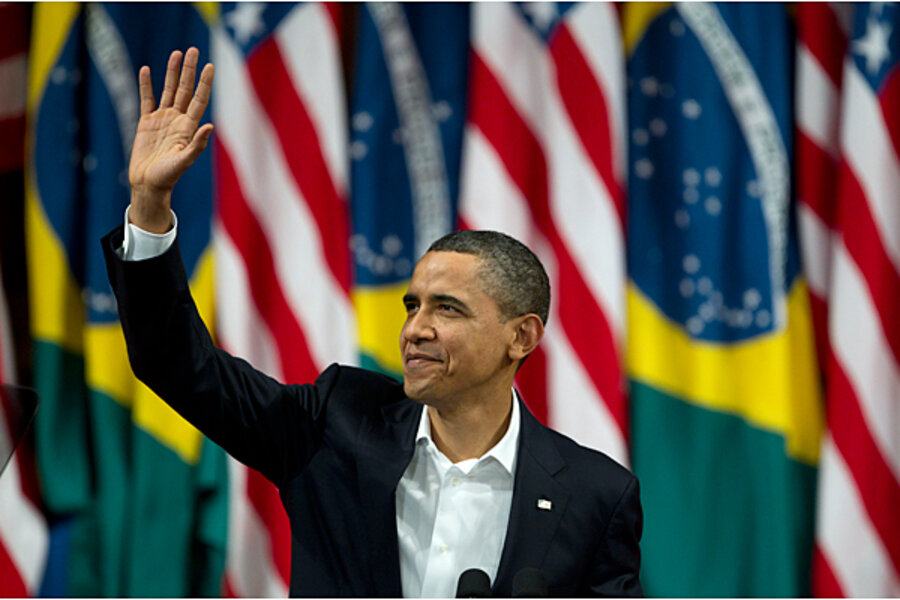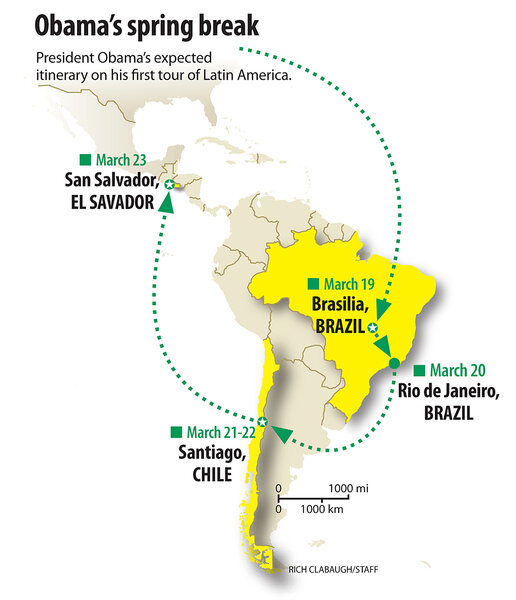China grabs Latin America, well ahead of Obama's outreach
| Madrid
President Obama's current visit to Latin America is widely seen as a move to counteract the rising influence of China, which is in the midst of an unprecedented energy grab in the oil- and mineral-rich region.
From oil to refineries, China is capturing and integrating Latin America as much as it can, securing at least $65 billion in deals throughout the region since 2010. The deals are expected to eventually translate into at least a million barrels of crude oil and refined products per day and growing markets on both sides of the continent.
The grab is not only unprecedented but also a significant game-changer in China’s rise as a world power, especially because the US plans to increasingly meet its own energy demand with Latin American oil, setting the stage for a future competition between both countries.
“Latin America is very important for China. I think that it’s as important as Africa,” which in 2009 supplied roughly 30 percent of China’s oil imports, says Keun-Wook Paik, an expert in the Chinese overseas energy expansion at the London-based think tank Chatham House. Latin America supplied about 2.5 percent of China's oil imports in 2009.
Think you know South America? Take our geography quiz.
Brazil’s cool reception to Mr. Obama this past weekend contrasts with China’s quiet but effective cash diplomacy in the region, home to the world’s second-biggest reserves after the Middle East. The Chinese yuan is contesting US hegemony by funding stadiums and dams and investing billions in strategic sectors.
A few examples:
- Earlier this month, Bridas Group, an Argentinean company half-owned by the mammoth China National Offshore Oil Corporation (CNOOC), finalized a deal to buy Exxon Mobil's oil refining and sales in Argentina, Uruguay, and Paraguay. CNOOC paid $3.1 billion for a 50 percent stake in Bridas earlier last year and the new entity paid another $7.1 billion to BP for its 60 percent stake in Pan American Energy.
- Last month, Chinese company Sinopec – Asia's biggest oil refiner – formalized a $7.1 billion contract to buy a 40 percent stake of the integrated Brazilian operations of Repsol, Spain’s biggest energy company.
- In 2010, China’s biggest energy companies signed deals to build refineries and pump oil in Venezuela, Cuba, and Brazil and to lease storage tanks in the Caribbean, in effect integrating the entire energy value chain to not only supply the homeland’s voracious appetite, but also the American continent.
Colombia canal?
But nothing would alter global energy markets as much as the Chinese proposal for an $7.6 billion dry canal through Colombia, a key US ally. It would compete with the Panama Canal and involve offloading merchandise, especially oil and refined products, on the Atlantic Coast, moving it via railway to the Pacific, and uploading to other ships.
Currently, the biggest oil tankers can’t even fit through the Panama Canal, making most Latin American oil too expensive for Asian markets because of the added shipping costs to transit under the continent, through the Strait of Magellan. Venezuela would be able to supply China and shed its dependence on oil exports to the US, its antagonist.
Venezuela appears more than willing to shift its supply route. Energy Minister Rafael Ramírez said in December that China’s energy mammoths Sinopec, CNOOC, and CNPC would together invest $40 billion through 2016 in four different projects that involve oil production of 800,000 barrels per day (b/d), offshore extraction of 1.2 cubic feet per day of natural gas, and the construction of a refinery geared for Venezuela’s heavy oil with a capacity of 200,000 b/d. Venezuela is also underwriting a $6 billion Chinese loan with its oil to finance the CNPC-led expansion of a Cuban refinery to process 150,000 b/d of heavy oil. And Venezuela and China are also jointly building a 400,000 b/d capacity refinery in southeast China, also geared for Venezuelan oil.
But skeptics of the dry canal say Colombia has exaggerated the proposal to pressure the US on trade. “No, it’s real. … There’s a proposal to build whole railway system that would even connect Venezuela with the Pacific,” Colombian President Juan Manuel Santos recently told the Financial Times. “We are of course very interested.”
Impact on US
Although US oil and derivative imports from Venezuela have been decreasing, they still account for more than 8 percent of all US petroleum imports (making Venezuela the fifth-largest oil exporter to the US, according to the Energy Information Administration). Colombia supplies another 3 percent, while Brazil and Ecuador together contribute around 5 percent of US oil imports.
A dry canal will make China a better client for all that oil, especially because US oil demand, like that of all developed countries, will not grow nearly as much as Asian consumers. Another among the many Chinese investments in the region was China’s Sinochem $3.1 billion purchase of 40 percent stakes in a Brazilian offshore oil field operated by StatoilHydro.
Washington’s response so far has been largely mute, especially because there is little way to oppose the deals. From China’s point of view though, there is little to worry about.
“China’s presence in Latin America has aroused great concern and anxiety in the US Administration, the media, and even the public,” Jiang Shixue, vice president of Chinese Association of Latin American studies, wrote in a recent policy paper. "In fact, China’s interest in Latin America is not to challenge the US dominance in the region, its ‘backyard,’ but to promote South-South cooperation in the economic sphere. Naturally, as a region with a large market and an abundance of resources, Latin America is highly complementary economically with China."
Integrating the chain
China finalized ventures starting in 2010 for varying stakes in projects that could eventually produce at least a low 1.3 million b/d and 835,000 b/d of refined products from South America. It also leased a 5 million barrel storage facility in the Caribbean.
That does not include cash-for-oil swaps signed in the past with Venezuela, Ecuador, and Brazil, or long-term oil supply contracts.
Chinese purchases this year alone secured it a minimum supply of 600,000 b/d, which today would account for about 15 percent of its total imports. More important, it gives it solid traction to expand in the future in Latin America and to supply both the American and Asian markets.
“I don’t know if all the oil will go back to China,” says Erica S. Downs, China fellow in the Brookings Institute and former energy analyst at the CIA focusing on Chinese energy and foreign policies.
Chinese companies “have established themselves as important marketers in the Americas and a lot will go to sell within the region," she adds.
Mr. Paik agrees: “The massive investment in local refineries in the region indicates that Beijing authority is more interested in building a value chain business that would maximize the benefit of the investment, together with expanded supply of refined heavy oil to China."
Spain wants a slice
Spain hopes to play an important role in that expansion. The Spanish government for years has marketed itself as a platform for Chinese firms to investing in Latin America.
The Sinopec-Repsol deal hunting agreement is a good example, analysts said. Repsol has the technology and experience after operating throughout South America for over two decades, and Sinopec is flush with cash from China’s nearly $2.85 trillion in foreign reserves.
“Spain is certainly in the right place to act as a ‘bridge’ between China and Latin America. Its affinity with the region in history, language, and culture makes it have more common ground than China does,” wrote Professor Shixue, who is also deputy director of the Institute of European Studies at the Beijing-based Chinese Academy of Social Sciences. “Indeed, cooperation between Sinopec and Repsol is a very promising gesture towards this end.”
Sinopec expects the Brazilian venture to eventually produce at least 200,000 b/d, but Repsol’s assets in oil-rich Brazilian offshore fields are still years from being fully developed. In fact, weeks after the chairmen of Repsol and Sinopec announced in January plans to jointly hunt for more ventures, the new Brazilian joint venture announced a new oil discovery off the Brazilian coast.
Whether Chinese companies use Spain remains a question, especially considering most of the other deals were signed directly.






